|
|
|
Sort Order |
|
|
|
Items / Page
|
|
|
|
|
|
|
| Srl | Item |
| 1 |
ID:
084943


|
|
|
|
|
| Publication |
2008.
|
| Summary/Abstract |
Iran's nuclear programme has brought ever-sharpening conflict with Israel, the United States, and the European Union. The Iranian public has been actively drawn into this debate, as the Iranian government cultivates support for its actions and by foreign appeals for change (including Bush administration support for regime change). This article explores data relating to public support for Iran's nuclear program. We utilize data from a nationally representative, face-to-face poll fielded in Iran in late 2006. The poll (n = 1,000) queried respondents about numerous domestic and external security concerns, including Iran's 'full nuclear fuel cycle' program. We present data on Iranian beliefs about Iran's nuclear program and the determinants of those beliefs. After discussing poll methodology and data integrity, the paper presents summary statistics on key variables about the nuclear program. We estimate three logit models to explain respondent beliefs about the program. The dependent variables address support for the program, the economic importance of the nuclear program, and beliefs that Iran will weaponize. Iranians' support for the program correlates with perceived status and deterrence benefits conferred by the program and opinions of the United States. Respondents' concerns about Israel do not drive support for the program. The paper concludes with a discussion of lessons learned from this study for future work of this type in Iran or other coercive environments.
|
|
|
|
|
|
|
|
|
|
|
|
|
|
|
|
| 2 |
ID:
093604
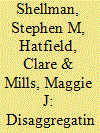

|
|
|
|
|
| Publication |
2010.
|
| Summary/Abstract |
While some of the intrastate war literature calls for the disaggregation of civil conflict, most of those studies focus on the geography of civil conflict failing to take into account the various actors involved in such conflicts. This study addresses the multi-actor nature of civil conflict by examining whether 'actor aggregation' affects the inferences drawn from quantitative studies of civil conflict. Using two cases, Cambodia (1980-2004) and Indonesia (1980-2004), the authors examine how multiple dissident groups' behavior aggregated together can affect the inferences drawn from quantitative studies of government-dissident interactions. The results demonstrate that researchers may draw different inferences and commit both Type I and Type II errors using different actor aggregations. The results have myriad implications for the study of civil conflict and conflict processes.
|
|
|
|
|
|
|
|
|
|
|
|
|
|
|
|
| 3 |
ID:
077774
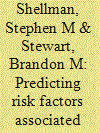

|
|
|
|
|
| Publication |
2007.
|
| Summary/Abstract |
This study predicts forced migration events by predicting the civil violence, poor economic conditions, and foreign interventions known to cause individuals to flee their homes in search of refuge. If we can predict forced migration, policy-makers can better plan for humanitarian crises. While the study is limited to predicting Haitian flight to the United States, its strength is its ability to predict weekly flows as opposed to annual flows, providing a greater level of predictive detail than its 'country-year' counterparts. We focus on Haiti given that it exhibits most, if not all, of the independent variables included in theories and models of forced migration. Within our temporal domain (1994-2004), Haiti experienced economic instability, low-intensity civil conflict, state repression, rebel dissent, and foreign intervention and influence. Given the model's performance, the study calls for the collection of disaggregated data in additional countries to provide more precise and useful early-warning models of forced migrant events
|
|
|
|
|
|
|
|
|
|
|
|
|
|
|
|
| 4 |
ID:
077740
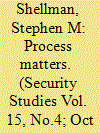

|
|
|
|
|
| Publication |
2006.
|
| Summary/Abstract |
Competing hypotheses on the relationship between government and dissident behavior emerge from both formal and empirical models. Yet, the current literature lacks a comprehensive theoretical account of such contradictory effects. This study develops a theory to account for a large number of competing hypotheses within a single framework. The theory explains various government and dissident tactical choices over the course of an internal political struggle by focusing on leaders, their motivations, and the link between their motivations and actions. The theory gives rise to a process model of sequential government-dissident interactions that is used to test several implied hypotheses. Empirical sequential time-series models of government and dissident behavior find support for most of the theory's implied hypotheses in Israel (1979-2002) and Afghanistan (1990-99).
|
|
|
|
|
|
|
|
|
|
|
|
|
|
|
|
| 5 |
ID:
120769
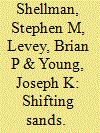

|
|
|
|
|
| Publication |
2013.
|
| Summary/Abstract |
Why does a dissident group go through phases of violence and nonviolence? Many studies of states and dissidents examine related issues by focusing on structural or rarely changing factors. In contrast, some more recent work focuses on dynamic interaction of participants. We suggest forecasting state-dissident interaction using insights from this dynamic approach while also incorporating structural factors. We explore this question by offering new data on the behavior of groups and governments collected using automated natural language processing techniques. These data provide information on who is doing what to whom at a directed-dyadic level. We also collected new data on the attitudes or sentiment of the masses using novel automated techniques. Since obtaining valid and reliable time-series public opinion data on mass attitudes towards a dissident group is extremely difficult, we have created automated sentiment data by scraping publicly available information written by members of the population and aggregating this information to create a pollof opinion at a discrete time period. We model the violence and nonviolence perpetrated by two groups: the Tamil Tigers in Sri Lanka and the Moro Islamic Liberation Front in the Philippines. We find encouraging results for predicting future phase shifts in violence when accounting for behaviors modeled with our data as opposed to models based solely on structural factors.
|
|
|
|
|
|
|
|
|
|
|
|
|
|
|
|
| 6 |
ID:
079948
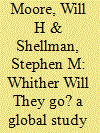

|
|
|
|
|
| Publication |
2007.
|
| Summary/Abstract |
common public perception in OECD countries suggests that refugees are mostly "economic migrants" in search of a better standard of living. Does the empirical record belie this belief? The authors explore that question within a rationalist approach using aggregate-level data that allow them to explore a variety of other covariates of the choice to seek refuge in one country relative to another. In addition to wages, they consider fear of persecution, culture, and the costs of relocation. The results are at odds with the "bogus refugees" image: the effect of average wages is mediated by proximity such that higher average wages are associated with fewer refugees, except among bordering countries. In addition, refugees seek asylum in neighboring countries, especially those at war with their own country or those experiencing a civil war. Those who seek refuge in countries other than their neighbors follow colonial ties
|
|
|
|
|
|
|
|
|
|
|
|
|
|
|
|
|
|
|
|
|